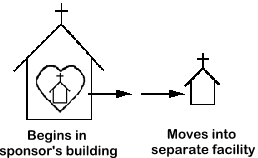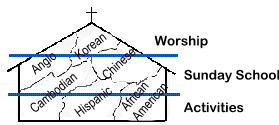
Home • Bibles in Your Language • Site Map
Urban Cross-Cultural Church Planting Models
Jerry L. Appleby, 1986
Reprinted with permission from Association of Nazarenes in Social ResearchNo two situations are the same. Each neighborhood, language, and church needs its own action plan. Each plan becomes its own model.
Several churches have followed somewhat similar patterns. The following criteria have been used to select and describe models that can be used as examples.
- There are actual churches that have examined by the author.
- They are successful in that growth and evangelism have taken place. It might be said that the model "worked."
- These models do not seem to have geographic sectional overtones or to have successful because of their geographic location.
- Certain adaptations can be made to these models without loss of workability. All the characteristics may not fit a given situation, but the models can still be a usable plan.
These examples are not meant to be exhaustive, but illustrative. Other examples no doubt do exist. God-given ingenuity will probably create more in the future.
I. Churches started at a physical distance from the sponsor.
A. Natural Birth - a church decides to plant an ethnic church in a neighborhood geographically removed from the planting church.

1. Characteristics
a. Both key laymen and pastoral leaders saw spiritual needs in a specific ethnic neighborhood that were not being met.
b. They were able to transfer this burden to others in the church.
c. It was impossible to bring the people to the sponsor's neighborhood on a weekly basis.
- It was physically too far to transport them.
- The socio-economic differences would create a barrier.
- The language would create a wall between the sponsoring church and the ethnic church.
d. The ethnic neighborhood has a few evangelical churches but none of the sponsor's denomination.
e. Two ethnic families in the sponsoring church have retained their original language but adopted anglo culture.
2. Positive ideas from the model.
a. The people rightly believed the money they gave for this project was for missions.
b. They shared their facilities with the baby church for special occasions.
c. The sponsors were able to loan their building to the ethnic group, when the ethnics had important services.
d. The sponsoring church was able to support the ethnic church for a period of time.
e. People from the sponsoring church were able to offer advice and support to the mission in fund raising.
f. Leaders of the sponsoring church used their expertise in long range planning to help the ethnic work.
g. The ministers offered fellowship to the mission pastor in the beginning.
h. The Church Staff assisted in goals for weaning the mission work from the sponsoring church both in finance and leadership.
B. Adoption - a sponsoring church finds an existing church in another neighborhood and adopts it to help in its development.

1. Characteristics
a. The ethnic church is at both a physical and cultural distance from the sponsor.
b. The mission church needs guidance and help, as they are seeing no growth.
c. Facilities for the ethnic mission are located in target neighborhood, but are badly in need of repair.
d. The Sponsor Church with the trained talent and resources began to feel a burden.
e. Many from the adopted church are new in the United States and do not understand the American business structure. Some business matters like building payments, pastoral support, etc., are confusing to them.
2. Positive ideas from this model
a. The sponsoring pastor did research on the culture of the ethnic group and learned a few phrases of greeting in their language.
b. He educated his congregation on the culture of the mission.
c. He taught his church that they were giving to missions in their own city.
d. Using an interpreter the sponsoring church trained ethnic Sunday school workers, musicians, and social workers.
e. On Thanksgiving, the sponsoring members showed their love by reaching out to the extremely needy in the mission group.
f. The sponsoring church expressed tangible appreciation to the Mission pastor at Christmas.
g. Those with financial expertise gave leadership and training on tithing, budgeting, and a detailed program to help the mission be self sufficient.
h. English-as-a-second language was taught using the Bible as a text.
C. Implantation - a sponsoring church begins an ethnic mission in its buildings, realizing eventually it will need to be transplanted to a neighborhood where it can grow.

1. Characteristics
a. The sponsoring church has adequate space to begin a new work.
b. They have available transportation to bring in the ethnic group.
c. The target ethnic group lived generally in one geographical neighborhood. There was an existing church of the same denomination, as the target group in the neighborhood, but several problems existed.
- The existing church was very small.
- The pastor had no cross-cultural experience and could not give the needed help to the target group.
- The existing church could not financially, emotionally or spiritually support the target mission.
d. The sponsoring church agreed that when target group became strong they would be implanted in the existing church.
2. Positive ideas emerging from implantation.
a. The target church began in a positive supportive atmosphere.
b. All three churches involved were informed from the beginning of future plans.
c. The target mission received help from other uninvolved churches as they relocated to the small existing church.
d. The pastor of the existing church in the target neighborhood gained many insights into cross cultural church planting by being involved from the beginning.
Introduction to Multi-Congregational Churches
A recent study conducted by the Church of the Nazarene has resulted in proposed organizational changes to give guidance to several congregations sharing one facility (multi-congregations). In the report the following facts concerning multi-congregations in the denomination are revealed:
From its inception the Church of the Nazarene has recognized the opportunity to minister to these immigrant groups. Dr. Bresee had both Spanish and Chinese language works in the original First Church of the Nazarene in Los Angeles, California. Therefore, the mother church was a multi-congregational church.
Today, the most conservative statistics we have indicate there has been tremendous growth in multi-congregation churches since 1970. The number of U.S. and Canadian multi- congregation churches has grown from one in 1976 to 22 in 1980 and 121 in 1984. This is a 600% increase from 1981-1984. If this growth continues, it indicates that before 1990 at least 30% of our U.S. and Canadian churches will be multi-congregational. Of the 450 ethnic works in existence in 1983 (either fully organized churches or church-type missions) nearly 60% of them meet in the mulit-congregational church setting.
The reasons for the development of such churches are: The immediacy of the need -
People who have recently been uprooted from their cultural setting are very receptive to the Gospel message. To wait until we can reach many of these people groups by traditional means may be too late.When we see the potential for growth among Blacks, Koreans, Hispanics, Armenians, Filipinos, Chinese, Cambodians, and other ethnic groups, the possibilities for organizing new areas of ministry develop in words of the founder of the Church of the Nazarene, Dr. Phineas F. Bresee, "We are debtors to give the Gospel to every creature in the same measure that we have received it'"
Two subdivisions of multi-congregations will be considered with several models under each:
II. More than one organized Church meeting in the same building.
All congregations work in a continuing fellowship to build unity. All expenses associated with the use of the building facilities are shared proportionately by each group. Each group is equally accountable to the district or state church organization.
A. Natural Birth - a church that plants another church within its facilities with the intention of keeping it there.

1. Characteristics
a. The English speaking church is located in a multi-cultural neighborhood.
b. Through a survey this church found the community to have 5 major language groups including English.
c. Most of the people preferred to speak their own language and have major social contact within their own culture.
d. The youth and children spoke the common language, English, as they went to school and social events together. The exception to this group was preschoolers and recent overseas arrivals.
e. The cost of land prohibited the purchase of five different church properties.
f. The "Mother Church" had a building which could be converted for multi-use.
2. Positive ideas
a. The pastor of the English speaking church preached once a month for a year on Biblical understanding of culture, race relations, love and cross cultural evangelism. This took place before any non-English service started.
b. The planting took place systematically, starting with the largest language group represented in the neighborhood.
c. The financial support was through the mission giving of the church.
d. Each church was pastored by a person from the target ethnic group.
e. Eventually all buildings and properties become the responsibility of all the organized churches according to their abilities.
f. An elected council from each church governed the combined projects of the churches. These included building and properties needs, as well as Sunday school activities.
g. The 5 churches hired one youth pastor and one children's minister to pastor the combined needs since both age groups spoke English.
h. Each local church had their own evangelistic thrust, social outreach and the care of their own church family.
i. The council planned combined services and potluck dinners for cultural awareness once a quarter.
B. Adoption - church reaches out to an existing church in their neighborhood and "adopts" them into their church family. They share facilities but exist as two separate organizations.

1. Characteristics
a. This is an English speaking church with facilities larger than they presently need.
b. This congregation was aware it was in a multi-racial area.
c. They were approached by an existing ethnic church in the area who had no place to meet.
d. The doctrinal stand of both churches are similar.
e. Facilities could be shared by adjusting the time schedule.
f. An agreeable financial arrangement made each church able to exist easier than before.
2. Positive Ideas
a. A new sense of mission was felt by the adopting church as they shared their facilities.
b. The pastor led his people to the understanding that they were assisting in evangelizing a segment of the neighborhood that they previously had not been able to reach.
c. Because of the generosity of the English speaking church the ethnic group developed deep respect for them as Americans and for their denomination.
d. Picnics, combined services and informal fellowship brought each congregation to a new understanding of one another.
e. The English church provided a new base for sponsoring immigrants from the ethnic homeland. Many families were united.
f. English as a second language was taught.
g. Youth and children's English classes were shared by both congregations since they went to school together.
C. Transition - the neighborhood has changed. A new church is formed to take over the facility as the existing culture dies out. Cities grow, evolve, and decline. Sometimes there will be a rebirth and resurrection. Transition is a relative term because it can be slight or a complete change. All of the examples in Chapter IV are examples of churches in transition. But in this case complete change has taken place in the community. For the church to continue to exist it had to have a racial as well as a socio-economic change.

1. Characteristics:
a. The neighborhood began racial changes about 12 years ago. It has made a 95% change now.
b. The church was white but as blacks moved in whites moved to the suburbs.
c. The church had a small debt, but it was too large for a struggling black church.
d. The maintenance and utilities were enormous.
e. The Congregation could not afford a staff.
f. The Church was plagued by vandalism, and problems of how to feed the poor, and other social problems.
2. Ideas
a. An interim pastor was called who was experienced in a changing neighborhood.
b. Whites and blacks attended Sunday afternoon discussions on issues involving the change.
c. Later a black pastor replaced the interim pastor. He started a service in free, gospel style. The traditional service of the past continued also.
d. The new congregation promoted uplift and self esteem. The blacks in that neighborhood were told six days a week they were a minority, but on Sunday they were made to feel important.
e. The solving of social problems were linked to the evangelistic outreach. The church organized small geographical groups designed to care for each person individually. These care units promoted the idea "everybody cares for you."
f. Because of the interim situation moving so smoothly no financial help was needed from outside sources.
III. More than one culture in one church organization.
This includes several congregations in one church organization, or, it could be several language classes meeting separately, yet all part of one organization. Each group or class has its own leader. Where possible, ethnic leadership is desirable. The local church sponsors these classes or groups and supports them financially. The groups is accountable to the pastor and local church board. Church board committees have the responsibilities of developing programs. These groups may or may not become fully organized churches. However, they may come into membership of the sponsoring organized local church.
A. Multi-Worship Service - when more than one worship service is held in the same facility. The service may be cultural, but is usually language based.

1. Characteristics:
a. The neighborhood consists of 4 distinct racial, cultural, and/or language groups.
b. The "mother" church wished to reach the neighborhood and its complex needs through the present structure and facilities.
c. The building owned was adequate to meet services in several areas at the same time.
d. Most of the young people and children speak English.
e. Immigration continues to feed the neighborhood with new people from the 4 main groups.
2. Ideas
a. Each congregation had its own pastor; they were staff members of the whole church.
b. Combined services were held as often as possible to promote unity.
c. Financial responsibilities were established among the ethnic congregations. Payments were made not as rent but to help with the church budget.
d. Representatives from each ethnic congregation served on the local church board of governing body.
e. All congregations Sunday schools met at the same time. Youth and children of all congregations met together when possible. Adults had elective classes including Bible study in their own language and English as a second language. In the ESL class, the Bible was used as a text, and studying English was combined with Bible truth.
f. Each language group had classes during the week to train their laymen.
g. Literature advertising the church was distributed in all four languages, there by displaying to the community a spirit of unity in the church.
B. Multi-Language Classes - many new immigrants are moving in who need to learn in their own language. Bible studies are altered to help meet their needs.

1. Characteristics
a. 10 different language groups of immigrant and refugees have moved into this neighborhood.
b. No other evangelical group is working with these groups.
c. All groups seem to co-exist in the neighborhood with little friction.
d. There is a strong desire among refugee and immigrant groups to make money in America. Most realize they must first learn English to get a good job.
e. The sponsoring church has adequate space to have several classes meeting simultaneously.
2. Positive Ideas
a. English-as-a-second language classes were set up. U.S. government literature on ethnics was used to understand the various cultures and language characteristics.
b. The church was altered to new immigrant arrivals by the local ethnic groups.
Social services were set up to help with clothing, food, housing, and adjustment to a new country for these newcomers.c. People graciously used their gifts to teach even when they had little training. Especially this was true among senior citizens.
d. A missionary who had had many successful years overseas was recruited to supervise the program. His support came from churches in the area.
e. This model is now ready to start worship services in a few of the language groups that have been receptive to the gospel.
C. Multi-Cultural - a church that designs its church services for a variety of cultural groups.

1. Characteristics
a. All cultures speak a common language. This is not always their mother tongue.
b. Most of these cultural groups are upward moving socio-economically and wish their children to learn and socialize in the language of the church. In this model that language is English.
c. The services tend to be less formal than average. Musical instruments, both stringed and brass, are often used.
d. Each cultural group is encouraged to promote social events and to keep them aware of their heritage.
2. Positive Ideas
a. The pastor stayed current on world news that involved the homelands of his new parishioners and used this material in his sermons.
b. Classes were taught to help children born in America to learn their own native language.
c. Public worship services were carefully sprinkled with prayers and songs from the languages represented.
d. The governing board was selected to include as many cultural groups as possible. This was done through careful nomination and not by designation of each group on the ballot.
e. Various cultural holidays and religious observations were recognized and celebrated when appropriate. Dressing in national costumes gave excitement to these special Sundays. Evangelism was encouraged by bringing family and friends to Church dinners with emphasis on one particular ethnic food.
These models stand as examples of churches which were willing to build bridges and reach cross-culturally to others with the gospel. This is a golden opportunity era for the Church in America. We must have an increasing number of churches who will develop their own guidelines and regulations in order to meet the challenge in their own neighborhood.
Reprinted with permission from Association of Nazarenes in Social Research
* Back to Ethnic Harvest site map
Copyright © 2015 Ethnic Harvest. All rights reserved.